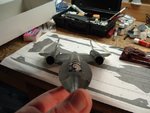- Thread starter
- #41
Matt308
Glock Perfection
The aft fuselage and nose is glued and drying. [first photo]
With both halves of the fuselage glued together, you can see the large gap along the glue line. [second photo] Not only is this a gap, but the lower fuselage is raised along the seam further complicating a proper fit. This is going to be my biggest challenge as my putty skills rank about a 2 on 10 scale. How I am gonna do this, not destroy the raised panel lines AND get a halfway decent putty job is worrying me.
Next step is to dry fit the landing gear doors. Revell made the kit to depict the gear down, so the gear doors are outsized and include gear door actuators molded right into the doors themselves. The main gear doors fit nicely with only a little trimming. The nose gear doors are another matter. About 1/3 of the door needs to be removed. Using some forceps to help keep the doors parallel with the work surface, I used some 60grit sandpaper to remove the extra material to allow the doors to mate flush. Here you can see the amount of material that I needed to remove (redline) and a piece under work. [third photo]
With both halves of the fuselage glued together, you can see the large gap along the glue line. [second photo] Not only is this a gap, but the lower fuselage is raised along the seam further complicating a proper fit. This is going to be my biggest challenge as my putty skills rank about a 2 on 10 scale. How I am gonna do this, not destroy the raised panel lines AND get a halfway decent putty job is worrying me.
Next step is to dry fit the landing gear doors. Revell made the kit to depict the gear down, so the gear doors are outsized and include gear door actuators molded right into the doors themselves. The main gear doors fit nicely with only a little trimming. The nose gear doors are another matter. About 1/3 of the door needs to be removed. Using some forceps to help keep the doors parallel with the work surface, I used some 60grit sandpaper to remove the extra material to allow the doors to mate flush. Here you can see the amount of material that I needed to remove (redline) and a piece under work. [third photo]




 Just rub like an eraser and off she comes.
Just rub like an eraser and off she comes.










